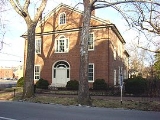
Hunt-Morgan House
Encyclopedia
The Hunt-Morgan House, historically known as Hopemont, is a Federal style
residence in Lexington, Kentucky
built in 1814 by John Wesley Hunt
, the first millionaire west of the Alleghenies
. The house is included in the Gratz Park Historic District
. The Alexander T. Hunt Civil War Museum is located on the second floor of the Hunt-Morgan House.
Other notable people that resided at Hopemont include John Wesley Hunt's grandson, General John Hunt Morgan
, a general in the Confederate Army
. Dr. Thomas Hunt Morgan
, the first Kentuckian to win the Nobel Prize
, was born in the house in 1866.

The House has many beautiful architectural features, including the Palladian
window with fan and sidelights that grace its front façade. In 1955 the Blue Grass Trust for Historic Preservation was formed to save this home from impending demolition. The organization restored the home to its Federal appearance.
The Hunt-Morgan House is located on the corner of Mill and Second Streets, at 201 N. Mill Street, in Lexington.
Federal architecture
Federal-style architecture is the name for the classicizing architecture built in the United States between c. 1780 and 1830, and particularly from 1785 to 1815. This style shares its name with its era, the Federal Period. The name Federal style is also used in association with furniture design...
residence in Lexington, Kentucky
Lexington, Kentucky
Lexington is the second-largest city in Kentucky and the 63rd largest in the US. Known as the "Thoroughbred City" and the "Horse Capital of the World", it is located in the heart of Kentucky's Bluegrass region...
built in 1814 by John Wesley Hunt
John Wesley Hunt
John Wesley Hunt was a prominent businessman and early civic leader in Lexington, Kentucky. He was one of the first millionaires west of the Allegheny Mountains....
, the first millionaire west of the Alleghenies
Allegheny Mountains
The Allegheny Mountain Range , also spelled Alleghany, Allegany and, informally, the Alleghenies, is part of the vast Appalachian Mountain Range of the eastern United States and Canada...
. The house is included in the Gratz Park Historic District
Gratz Park Historic District
The Gratz Park is a neighborhood and historic district located just north of downtown Lexington, Kentucky. It was named after early Lexington businessman Benjamin Gratz whose home stands on the corner of Mill and New streets at the edge of Gratz Park...
. The Alexander T. Hunt Civil War Museum is located on the second floor of the Hunt-Morgan House.
Other notable people that resided at Hopemont include John Wesley Hunt's grandson, General John Hunt Morgan
John Hunt Morgan
John Hunt Morgan was a Confederate general and cavalry officer in the American Civil War.Morgan is best known for Morgan's Raid when, in 1863, he and his men rode over 1,000 miles covering a region from Tennessee, up through Kentucky, into Indiana and on to southern Ohio...
, a general in the Confederate Army
Confederate States Army
The Confederate States Army was the army of the Confederate States of America while the Confederacy existed during the American Civil War. On February 8, 1861, delegates from the seven Deep South states which had already declared their secession from the United States of America adopted the...
. Dr. Thomas Hunt Morgan
Thomas Hunt Morgan
Thomas Hunt Morgan was an American evolutionary biologist, geneticist and embryologist and science author who won the Nobel Prize in Physiology or Medicine in 1933 for discoveries relating the role the chromosome plays in heredity.Morgan received his PhD from Johns Hopkins University in zoology...
, the first Kentuckian to win the Nobel Prize
Nobel Prize
The Nobel Prizes are annual international awards bestowed by Scandinavian committees in recognition of cultural and scientific advances. The will of the Swedish chemist Alfred Nobel, the inventor of dynamite, established the prizes in 1895...
, was born in the house in 1866.

The House has many beautiful architectural features, including the Palladian
Palladian architecture
Palladian architecture is a European style of architecture derived from the designs of the Venetian architect Andrea Palladio . The term "Palladian" normally refers to buildings in a style inspired by Palladio's own work; that which is recognised as Palladian architecture today is an evolution of...
window with fan and sidelights that grace its front façade. In 1955 the Blue Grass Trust for Historic Preservation was formed to save this home from impending demolition. The organization restored the home to its Federal appearance.
The Hunt-Morgan House is located on the corner of Mill and Second Streets, at 201 N. Mill Street, in Lexington.

